HOTSPOT -
You are developing an application that includes language translation.
The application will translate text retrieved by using a function named getTextToBeTranslated. The text can be in one of many languages. The content of the text must remain within the Americas Azure geography.
You need to develop code to translate the text to a single language.
How should you complete the code? To answer, select the appropriate options in the answer area.
NOTE: Each correct selection is worth one point.
Hot Area: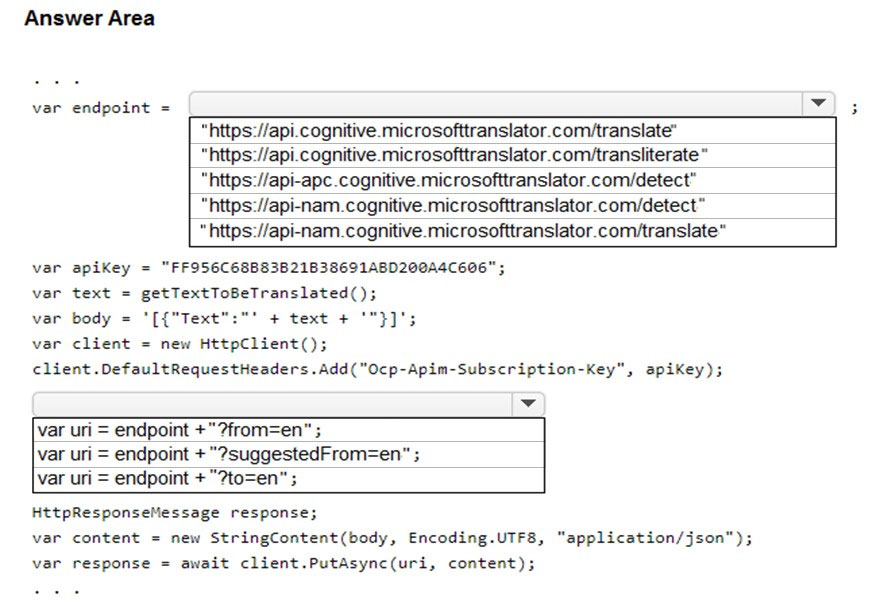
Answer:
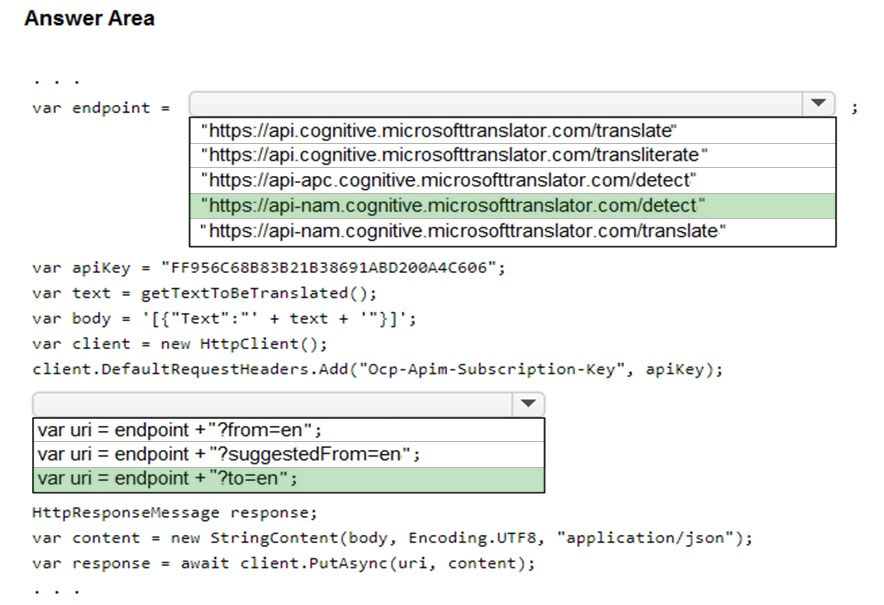
You are building a conversational language understanding model.
You need to enable active learning.
What should you do?
Answer:
C
Reference:
https://docs.microsoft.com/en-us/azure/cognitive-services/luis/luis-how-to-review-endpoint-utterances#log-user-queries-to-enable-active-learning
HOTSPOT -
You run the following command.
For each of the following statements, select Yes if the statement is true. Otherwise, select No.
NOTE: Each correct selection is worth one point.
Hot Area: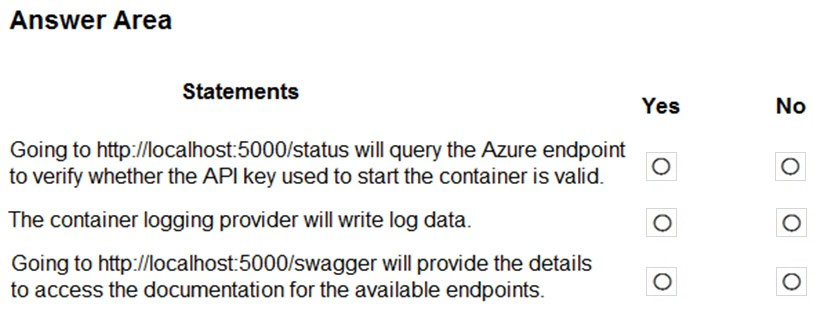
Answer:
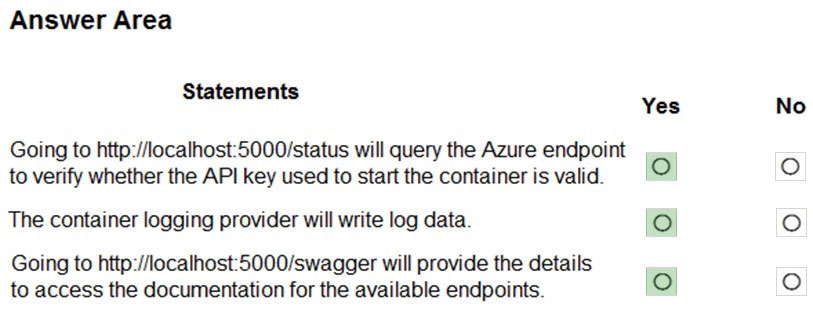
Box 1: Yes -
http://localhost:5000/status : Also requested with GET, this verifies if the api-key used to start the container is valid without causing an endpoint query.
Box 2: Yes -
The command saves container and LUIS logs to output mount at C:\output, located on container host
Box 3: Yes -
http://localhost:5000/swagger : The container provides a full set of documentation for the endpoints and a Try it out feature. With this feature, you can enter your settings into a web-based HTML form and make the query without having to write any code. After the query returns, an example CURL command is provided to demonstrate the HTTP headers and body format that's required.
Reference:
https://docs.microsoft.com/en-us/azure/cognitive-services/luis/luis-container-howto
You are building a Language Understanding model for an e-commerce platform.
You need to construct an entity to capture billing addresses.
Which entity type should you use for the billing address?
Answer:
B
A regular expression entity extracts an entity based on a regular expression pattern you provide. It ignores case and ignores cultural variant. Regular expression is best for structured text or a predefined sequence of alphanumeric values that are expected in a certain format. For example:
Incorrect Answers:
C: The prebuilt geographyV2 entity detects places. Because this entity is already trained, you do not need to add example utterances containing GeographyV2 to the application intents. GeographyV2 entity is supported in English culture.
The geographical locations have subtypes: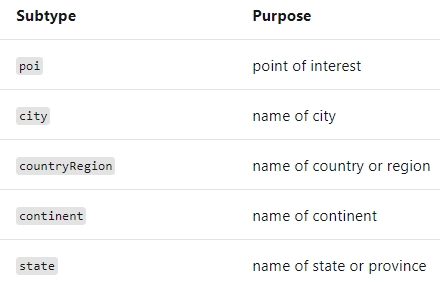
D: Pattern.any is a variable-length placeholder used only in a pattern's template utterance to mark where the entity begins and ends.
E: A list entity represents a fixed, closed set of related words along with their synonyms. You can use list entities to recognize multiple synonyms or variations and extract a normalized output for them. Use the recommend option to see suggestions for new words based on the current list.
Reference:
https://docs.microsoft.com/en-us/azure/cognitive-services/luis/luis-concept-entity-types
HOTSPOT -
You need to create a new resource that will be used to perform sentiment analysis and optical character recognition (OCR). The solution must meet the following requirements:
✑ Use a single key and endpoint to access multiple services.
✑ Consolidate billing for future services that you might use.
✑ Support the use of Computer Vision in the future.
How should you complete the HTTP request to create the new resource? To answer, select the appropriate options in the answer area.
NOTE: Each correct selection is worth one point.
Hot Area: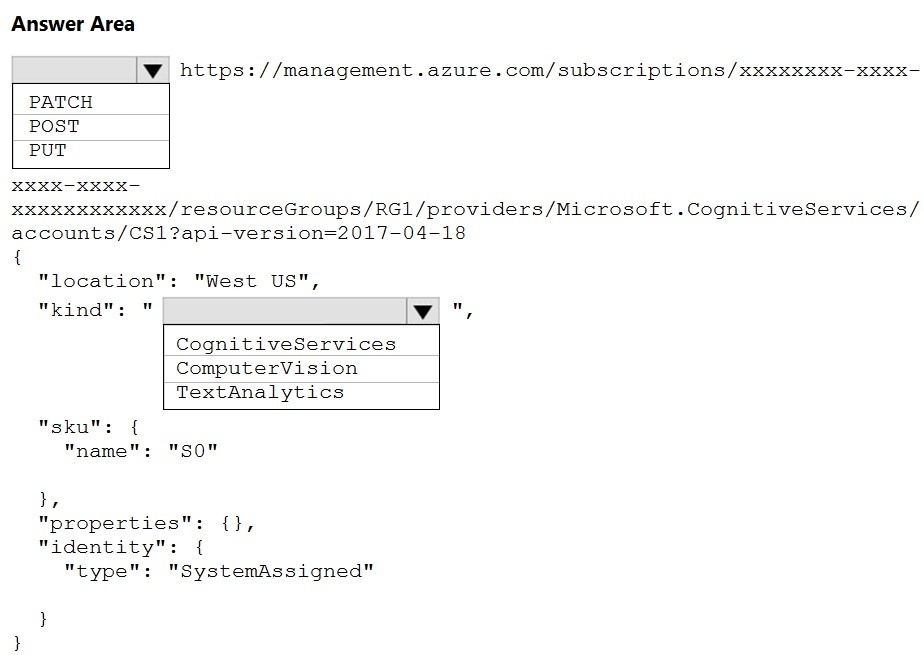
Answer:
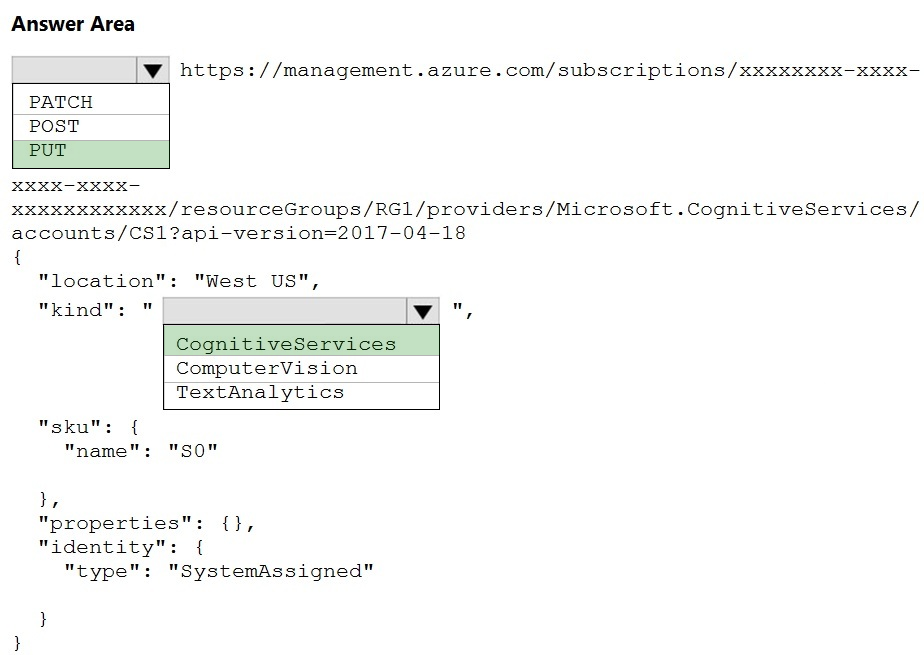
Box 1: PUT -
Sample Request: PUT https://management.azure.com/subscriptions/00000000-0000-0000-0000-000000000000/resourceGroups/test-rg/providers/
Microsoft.DeviceUpdate/accounts/contoso?api-version=2020-03-01-preview
Incorrect Answers:
PATCH is for updates.
Box 2: CognitiveServices -
Microsoft Azure Cognitive Services provide us to use its pre-trained models for various Business Problems related to Machine Learning.
List of Different Services are:
✑ Decision
✑ Language (includes sentiment analysis)
✑ Speech
✑ Vision (includes OCR)
✑ Web Search
Reference:
https://docs.microsoft.com/en-us/rest/api/deviceupdate/resourcemanager/accounts/create https://www.analyticsvidhya.com/blog/2020/12/microsoft-azure-cognitive-services-api-for-ai-development/
You are developing a new sales system that will process the video and text from a public-facing website.
You plan to monitor the sales system to ensure that it provides equitable results regardless of the user's location or background.
Which two responsible AI principles provide guidance to meet the monitoring requirements? Each correct answer presents part of the solution.
NOTE: Each correct selection is worth one point.
Answer:
BD
AI systems should treat all people fairly.
AI systems should perform reliably and safely.
Reference:
https://docs.microsoft.com/en-us/azure/cloud-adoption-framework/strategy/responsible-ai
DRAG DROP -
You plan to use containerized versions of the Anomaly Detector API on local devices for testing and in on-premises datacenters.
You need to ensure that the containerized deployments meet the following requirements:
✑ Prevent billing and API information from being stored in the command-line histories of the devices that run the container.
✑ Control access to the container images by using Azure role-based access control (Azure RBAC).
Which four actions should you perform in sequence? To answer, move the appropriate actions from the list of actions to the answer area and arrange them in the correct order.
NOTE: More than one order of answer choices is correct. You will receive credit for any of the correct orders you select.
Select and Place:
Answer:

Step 1: Pull the Anomaly Detector container image.
Step 2: Create a custom Dockerfile
Step 3: Push the image to an Azure container registry.
To push an image to an Azure Container registry, you must first have an image.
Step 4: Distribute the docker run script
Use the docker run command to run the containers.
Reference:
https://docs.microsoft.com/en-us/azure/container-registry/container-registry-intro
HOTSPOT -
You plan to deploy a containerized version of an Azure Cognitive Services service that will be used for text analysis.
You configure https://contoso.cognitiveservices.azure.com as the endpoint URI for the service, and you pull the latest version of the Text Analytics
Sentiment Analysis container.
You need to run the container on an Azure virtual machine by using Docker.
How should you complete the command? To answer, select the appropriate options in the answer area.
NOTE: Each correct selection is worth one point.
Hot Area:
Answer:
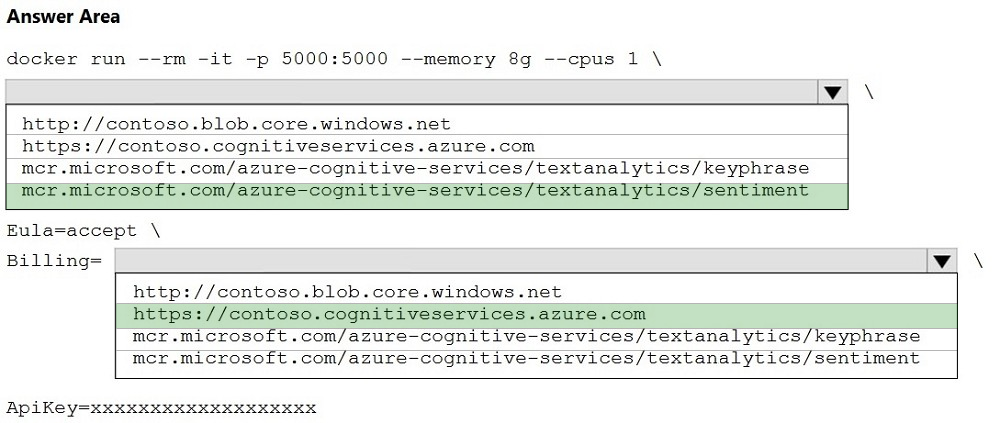
Box 1: mcr.microsoft.com/azure-cognitive-services/textanalytics/sentiment
To run the Sentiment Analysis v3 container, execute the following docker run command. docker run --rm -it -p 5000:5000 --memory 8g --cpus 1 \ mcr.microsoft.com/azure-cognitive-services/textanalytics/sentiment \
Eula=accept \
Billing={ENDPOINT_URI} \
ApiKey={API_KEY} is the endpoint for accessing the Text Analytics API. https://<your-custom-subdomain>.cognitiveservices.azure.com
Box 2: https://contoso.cognitiveservices.azure.com
{ENDPOINT_URI} is the endpoint for accessing the Text Analytics API: https://<your-custom-subdomain>.cognitiveservices.a The endpoint for accessing the Text
Analytics API. zure.com -
Reference:
https://docs.microsoft.com/en-us/azure/cognitive-services/text-analytics/how-tos/text-analytics-how-to-install-containers?tabs=sentiment
You need to upload speech samples to a Speech Studio project for use in training.
How should you upload the samples?
Answer:
B
To upload your data, navigate to the Speech Studio . From the portal, click Upload data to launch the wizard and create your first dataset. You'll be asked to select a speech data type for your dataset, before allowing you to upload your data.
The default audio streaming format is WAV
Use this table to ensure that your audio files are formatted correctly for use with Custom Speech: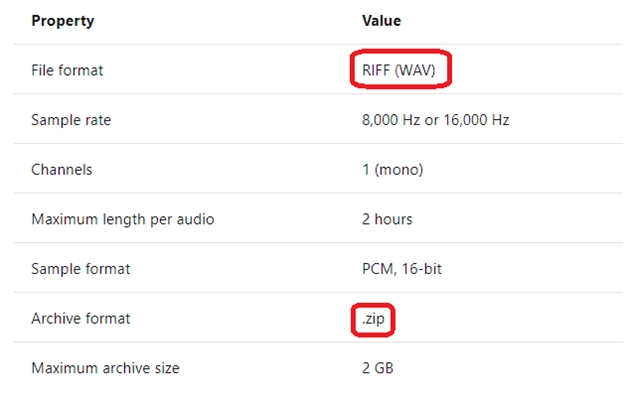
Reference:
https://docs.microsoft.com/en-us/azure/cognitive-services/speech-service/how-to-custom-speech-test-and-train
You are developing a method for an application that uses the Translator API.
The method will receive the content of a webpage, and then translate the content into Greek (el). The result will also contain a transliteration that uses the Roman alphabet.
You need to create the URI for the call to the Translator API.
You have the following URI.
https://api.cognitive.microsofttranslator.com/translate?api-version=3.0
Which three additional query parameters should you include in the URI? Each correct answer presents part of the solution.
NOTE: Each correct selection is worth one point.
Answer:
CDF
C: textType is an optional parameter. It defines whether the text being translated is plain text or HTML text (used for web pages).
D: to is a required parameter. It specifies the language of the output text. The target language must be one of the supported languages included in the translation scope.
F: toScript is an optional parameter. It specifies the script of the translated text.
We use Latin (Roman alphabet) script.
Reference:
https://docs.microsoft.com/en-us/azure/cognitive-services/translator/reference/v3-0-translate